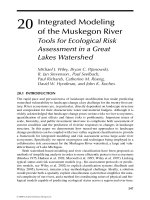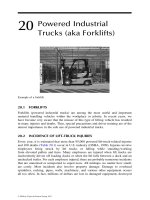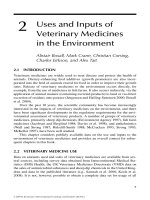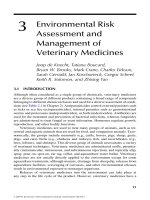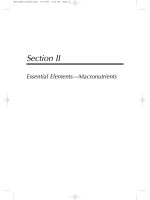Springer Old Growth Forests - Chapter 20 ppt
Bạn đang xem bản rút gọn của tài liệu. Xem và tải ngay bản đầy đủ của tài liệu tại đây (90.83 KB, 11 trang )
Chapter 20
Old-Growth Forests in the Context of
International Environmental Agreements
Annette Freibauer
20.1 Introduction
Forests are included in several political negotiations and legal documents under the
United Nations (UN). This chapter focusses on the three most relevant and dynamic
UN political processes in the context of old-growth forests: The UN Framework
Convention on Climate Change (UNFCCC), the Convention on Biological Diver-
sity (CBD), and the UN Forum on Forests (UNFF). Forests are also addressed by
the UN Convention on Comba ting Desertification and the Ramsar Convention on
wetlands.
Old-growth forests are defined by biological and ecological criteria, which differ
from the criteria and categories applied in international environmental agreements.
The absence of human impact is no clear criterion for old-growth forests. Old-
growth forests can be managed or unmanaged, and can be primary or secondary
forests (see Chap. 2, by Wirth et al., this volume).
Following the definitions in Chap. 2 of this book, old-growth forests are
characterised by
1) a relatively old age (existence of large old late-successional tree species with
ages close to their life expectancy; mean age half the lifespan of the dominat-
ing trees),
2) structural and compositional features witnessing self-replacement through
gap-phase dynamics (uneven-aged, regeneration of shade-tolerant species,
presence of canopy gaps, large snags and logs in varying stages of decay).
The question arises whether it matters in the context of international environ-
mental agreements if forests are in their late stages of succession. This chapter
summarises the present status of old-growth forests in global environmental agree-
ments and discusses promising options to include old-growth forests in future
phases of these agreements.
The following sections (1) give an introduction to the UNFCCC, CBD and
UNFF and show the role of forests in these UN political processes; (2) highlight
characteristics of old-growt h forests relevant for the UNFCCC, CBD and UNFF,
C. Wirth et al. (eds.), Old‐Growth Forests, Ecological Studies 207, 451
DOI: 10.1007/978‐3‐540‐92706‐8 20,
#
Springer‐Verlag Berlin Heidelberg 2009
and analyse how they are reflected in the context of the agreements; and (3) assess
how and to what extent old-growth forests could be considered in future stages of
these international environmental agreements.
20.2 Forests in UN Processes
20.2.1 UN Framework Convention on Climate Change
The ultimate objective of the UNFCCC (Article 2) is the ‘‘stabilisation of green-
house gas concentrations in the atmosphere at a level that would prevent dangerous
anthropogenic interference with the climate system. Such a level should be
achieved within a time-frame sufficient to allow ecosystems to adapt naturally to
climate change , to ensure that food production is not threatened and to enable
economic development to proceed in a sustainabl e manner’’ (UNFCCC 1992,
1997, 2002).
According to this objective, the UNFCCC addresses only anthropogenic green-
house gas emissions and abatement of adverse consequences of their emission. This
objective was interpreted by policy makers, and in the IPCC Good Practice Guid-
ance (IPCC 2004), as a restriction to managed forests. Unmanaged forests hosting
the great majority of old-growth forests are not considered in the current activit ies
under the UNFCCC and the Kyoto Protocol. As of October 2007, 191 countries,
with some exceptions, e.g. Iraq and Somalia, have ratified the UNFC CC. Almost
the entire global forest area (99.8%) is located in signatory states of the UNFCCC.
However, it is left to the individual signatory states to define what constitutes
‘‘managed forests’’ (Ho
¨
hne et al. 2007). Depending on the choice of definition of
‘‘managed forest’’, the UNFCCC addresses as much as 92% of global forests if all
types of uses are included, but down to 34% of global forests if only the production
function is included (see Table 20.1). The 24% of global forests that are used for
protection, conservation or social services (see Table 20.1) are likely to bear a
significant share of old-growth forests. These forest uses, however, can be missed
by a narrow definition of ‘‘managed forest’’ restricted to timber production.
The member countries of the UNFCCC need to submit national inventory
reports including the carbon stock changes in forests. Five ecosystem carbon
pools have to be considered unless it can be proven that a pool is not a carbon
source: Aboveground biomass, belowground biomass, deadwood litter and soil. In
practice, most of the reports concentrate on biomass. This is also true for the
country reports for the FAO Forest Resource Assessment (FAO 2005; Marklund
and Schoene 2006). Changes in non-biomass carbon pools particularly relevant
for old-growth forests [cf. Chaps. 5 (Wirth and Lichstein), 6 (Harmon), and 11
(Gleixner et al.), this volume for dynamics of dead wood and soil carbon, respec-
tively] are associated with large uncertainties or are current ly ignored by more
than half of the reporting countries to the FAO (Fig. 20.1).
452 A. Freibauer
Table 20.1 Forest area and its primary use in 2005 (FAO 2005)
Region Total forest area
(1,000 ha)
Production
(%)
Protection
(%)
Conservation
(%)
Social
services (%)
Multiple
purpose (%)
None or
unknown (%)
Eastern and Southern Africa 226,534 19.4 2.8 9.5 n.s. 39.0 29.1
Northern Africa 131,048 35.2 10.0 10.4 n.s. 16.8 27.7
Western and Central Africa 277,829 44.6 1.9 35.0 0.3 8.1 10.1
South and South-east Asia 283,127 42.4 20.9 20.2 0.1 13.3 3.2
Western and Central Asia 43,588 22.2 30.0 6.4 2.1 39.3 n.s.
Europe 1,001,394 73.1 9.1 3.8 2.3 10.7 1.0
Caribbean 5,974 28.1 37.0 20.2 0.1 1.4 13.3
Central America 22,411 14.8 4.8 37.8 0.2 34.6 7.8
North America 677,464 6.0 0.1 11.8 0.0 78.9 3.3
Oceania 206,254 11.0 0.2 14.4 n.s. 63.5 10.8
South America 831,540 11.6 11.3 14.4 13.7 34.6 14.5
World 3,952,025 34.1 9.3 11.2 3.7 33.8 7.8
20 Old Growth Forests in the Context of International Environmental Agreements 453
Article 4(d) of the UNFCCC commits count ries to ‘‘promote sustainable man-
agement, and promote and cooperate in the conservation and enhancement, as
appropriate, of sinks and reservoirs of all greenhouse gases’’ (UNFCCC 1997).
The Marrakech Accords set principles for the first commitment period under the
Kyoto Protocol (2008 2012), e.g. ‘‘that the implementation of land use, land-use
change and forestry activities contributes to the conservation of biodiversity and
sustainable use of natural resources’’ (UNFCCC 1997).
However, these principles are not legally binding. The term ‘‘sustainable use of
natural resources’’ is not defined.
The Kyoto Protocol (UNFCCC 1997) sets mandatory emission limitation
targets for industrial countries. The Kyoto Protocol has been ratified by 84
states, among which are the European Union (EU) and its Member States,
Russia, Japan, Canada, and Australia, but not the United States. The Kyoto
Protocol originally aimed at reducing emissions from fossil fuel use, but also
includes some land use options (Ho
¨
hne et al. 2007). Carbon stock changes
created by afforestation, reforestation and deforestation (Article 3.3) are accounted
on a mandatory basis even though several countries opted to report other categories
of land management, such as forest management (Article 3.4). Twenty signatory
countries, including the Russian Federation, Japan and many EU member states, but
not Canada, have decided to account for forest management. These countries host
25% of the global forest area ; 72% of these forests are used primarily for produc-
tion, 13% for multiple purposes, 9% for protection, 4% for conservation, and 2% for
social services (FAO 2005). It can be expected that most, if not all of the forest area
in these countries will be included in the national accounting under the Kyoto
Protocol.
Fig. 20.1 Response rate (in %) for carbon reporting by countries to the Food and Agriculture
Organization Forest Resources Assessment (FAO FRA) 2005 (FAO 2005). Adapted from
Marklund and Schoene (2006)
454 A. Freibauer
20.2.2 Convention on Biological Diversity
The objectives of the Convention on Biological Diversity CBD (Article 1) are ‘‘
the conservation of biolo gical diversity, the sustainable use of its components and
the fair and equitable sharing of the benefits arising out of the utilisation of genetic
resources ’’ (CBD 1992). Among other means, the objectives shall be achieved
via national strategies, plans and programmes for the conservation and sustainable
use of biological diversity (Article 6), and in situ conservation, e.g. by national
systems of protected areas (Article 8).
The 2010 Biodiversity Target with various Focal Areas, Goals and Targets was
decided together with indicators of succe ss. As of April 2009, the CBD has 9
member countries, excluding e.g. Brunei Darussalam, Iraq, Somalia and the United
States. Ninety-two percent of the global forest area is located in member countries
of the CBD.
The CBD addresses all managed and unmanaged forests and urges its parties to
apply the principles of the ecosystem approach. Forest ecosystems receive special
attention under the CBD via the working programmes on forest biodiversity and on
protected areas. Forest protected areas do not exclude commercial use.
Even more than the UNFCCC, the implementation of the CBD relies on the
intentions of individual signatory states to act because the CBD has no international
compliance regime. In Europe, cooperation among countries for forest biodiversity
is fostered by the Ministerial Con ference on the Protection of Forests in Europe
(MCPFE) as well as by the Pan-European Biological and Landscape Diversity
Strategy (PEBLDS).
The synthesis of progress reported in the third national reports to the CBD
shows that among all ecosystem types, forests have received the greatest attention
(CBD-WGRI 2007b). The thematic programme of work on forest biodiversity has
been implemented with high priority by almost 70% of the reporting countries,
sometimes even with quantitative national targets for total forest area, the increases
in forest area, and protected areas coverage (CBD-WGRI 2007b, 2007a). Forest
biodiversity targets have been integrated into forestry and development plans.
Measures for forest protection, rehabilitation, restoration, conservation of
threatened species, taxonomic research and activities, sustainable forest manage-
ment and reforestation, and improving the knowledge basis have been introduced
by 94% of the reporting countries. Many countries have established protected forest
area networ ks (CBD-WGRI 2007a). However, it has to be noted that the reports on
which the synthesis was based are voluntary and reports are not reviewed. There are
no criteria to substantiate, quantify or compare progress among countries, thus,
despite the large number actions described, the high amount of attention paid to
forest ecosystems does not necessarily equate to significant progress in the protec-
tion of forests.
20 Old Growth Forests in the Context of International Environmental Agreements 455
20.2.3 UN Forum on Forests (UNFF)
The UNFF is a forum towards an international agreement on forests ‘‘to promote the
management, conservation and sustainable development of all types of forests and
strengthen long-term political commitment to this end’’ (IFF 2000).
The 1992 Rio summit failed to agree on an international forest convention. Since
then, 25 years of negotiations at three successional UN fora have failed, by April
2009, to set up any legally binding international agreement. Between 1995 and
1997, proposals for action to support the management, conservation and sustain-
able development of forests were developed by the Intergovernmental Panel on
Forests (IPF) under the UN Commission on Sustainable Development (CSD). The
recommendations of the IPF were further negotiated between 1997 and 2000 under
the Intergovernmental Forum on Forests (IFF). In February 2000, the IFF issued its
final report, which included a recommendation for an international arrangement on
forests. As a consequence, the United Nations Economic and Social Council
(ECOSOC) adopt ed a resolution outlining an international arrangement on forests
and establishing the UNFF as a subsidiary body of ECOSOC. Since 2000, interna-
tional negotiations have continued under UNFF.
In 2006, UNFF agreed on ‘‘shared global objectives on forests’’ (UNFF 2006):
1) Reverse the loss of forest cover worldwide through sustainable forest manage-
ment (SFM) including protection, restoration, afforestation and reforestation,
and increase efforts to prevent forest degradation;
2) Enhance forest-based economic, social and environmental benefits, including by
improving the livelihoods of forest-dependent people;
3) Increase significantly the area of protected forests and other sustainably man-
aged forests, and increase the proportion of forest products derived from sus-
tainably managed forests; and
4) Reverse the decline in official development assistance for sustainable forest
management and mobilise sign ificantly increased new and additional financi al
resources from all sources for the implementation of SFM.
A non-legally binding instrument on all types of forests was adopted under
UNFFF on 28 April 2007. The purpose of this instrument is (UNFF 2007):
a) to strengthen political commitment and action at all levels to implement effec-
tively sustainable management of all types of forests and to achieve the shared
global objectives on forests;
b) to enhance the contribution of forests to the achievement of the internationally
agreed development goals, in particular with respect to poverty eradication and
environmental sustainability;
c) to provide a framework for national action and international cooperation.
456 A. Freibauer
The instrument is voluntary and non-legally binding
1
. Each state is responsible
for the sustai nable management of its forests and for the enforcement of is forest-
related laws, so that the instrument remains without international control.
International negotiations about forests proved a lot more difficult than those
about climate change, biodiversity or desertification. Major resistance has emerged
from fears of losing some of the national control over forests and forest products
and of national sovereign rights to exploit forest resources. The definition of
sustainable forest management was also controversial. In conclusion, UNFF has
not achieved any mandatory international obligations nor international control of
unsustainable forest use.
20.3 Consideration of Old-Growth Forests in UN Processes
20.3.1 Old-Growth Forests and the UN Framework Convention
on Climate Change
Old-growth forests are usually characterised by high carbon stock densities [t C ha
–1
]
in all carbon pools considered under the UNFCCC (cf. Chaps. 5 (Wirth and
Lichstein), 6 (Harmon), and 11 (Gleixner et al.), this volume, for dynamics of
dead wood and soil carbon, respectively). However, due to the sensitivity of the
carbon pools in biomass, dead wood and litter, large and fast carbon losses can be
triggered by disturbance.
Existing carbon stocks are not a criterion under the UNFCCC and the Kyoto
Protocol, which consider only carbon stock changes. But high carbon stock den-
sities are relevant in the context of potential emissions by disturbance, e.g. by
degradation and deforestation.
Old-growth forests are treated by the UNFCCC as all other forests. In cases
where old-growth forests fall under the category ‘‘managed’’, their carbon stock
changes are reported under the UNFCCC. The industrial signatory states of the
Kyoto Protocol need to account for CO
2
emissions from the deforestation of
forests, including old-growth forests (Article 3.3), and if they have elected to
adopt Article 3.4 (Forest Management) they need to account for disturbance and
degradation occurring in their forests, including old-growth forests. But if old-
growth forests are considered ‘‘unmanaged’’ they are excluded from the UNFCCC
and the Kyoto Protocol, because for unmanaged forests it is assumed that carbon
stocks do not change by direct human action. This assumption is based on the
paradigm that, as succession proceeds, ecosystem carbon stocks finally reach an
equilibrium where gains and losses of carbon are balanced (Odum 1969).
Negotiations about an international climate change agreement for the period
after 2012 are in progress. Although the scope and rules for the future are yet
1
Details of the negotiations and the final text of the non legally binding instrument can be found at
/>20 Old Growth Forests in the Context of International Environmental Agreements 457
unclear, it can be anticipated that forests will be more comprehensively included.
A new mechanism is being developed for incentives to reduce emissions from
deforestation and degradation (REDD) in developing nations. This is especially
important since most developing countries are in the tropics, where the fraction of
old-growth forest within the primary forest landscape is particularly high compared
with other biomes (see Fig. 2.7 in Chap. 2 by Wirth et al., this volume). Old-growth
forests in developing nations endangered by deforestation or degradation could be
conserved under REDD mechanisms.
20.3.2 Old-Growth Forests and the Convention
on Biological Diversity
The high structural and species richness, the existence of large old trees, and the
significant amounts of standing and lying dead wood in old-growth forests create
habitats of high value for the conservation of biodiversity [see e.g. Chaps. 13
(Bergeron and Harper), 15 (Schulze et al.), 16 (Armesto et al.), and 19 (Frank et al.),
this volume]. Old-growth forests should therefore be, and have already partly been,
priority areas for CBD targets such as protected areas, conservation of threatened
species, and management guidelines (‘‘ecosystem approach’’). Old-growth forests
are specifically addressed by some countries. For example, Estonia’s Nature Con-
servation Development Plan includes the target to maintain at least one-third of all
forests more than 100 years old (CBD-WGRI 2007b). Methods for mapping old-
growth forests based on forest inventories or remote sensing have been devised for
many regions [see Chaps. 2 (Wirth et al.) and 18 (Achard et al.), this volume].
Old-growth forests are not an official forest category under the CBD. Neverthe-
less, of all the existing international environmental agreements, the CBD is best
suited to promote the conservation of old-growth forests because it specifically
addresses forests rich in biodiversity. However, unlike the compliance regime
under the UNFCCC, there is no enforcement of national commitments, e.g. to
achieve the 2010 Biodiversity Target.
20.3.3 Old-Growth Forests and the UN Forest Focus
The UNFF would ideally provide an integrative platform on which the various
specific features of old-growth forests for carbon, biodiversity, ecosystem functions
and sustainable management could be balanced. However, as mentioned above, the
UNFF process has so far failed to achieve an international agreement on its
implementation, and still has the weakest legal structure of all UN processes
relevant for old-growth forests.
458 A. Freibauer
20.4 Potential Role of Old-Growth Forests in Future
International Environmental Agreements
The high amount and long residence time of carbon stored in old-growth forests is
not valued in climate policy (WBGU 1998; Schulze et al. 2002). However, Article
4.1(d) of the UNFCCC (see above) includes the conservation of carbon in ecosys-
tem pools. In contrast, the link between the mitigation of climate change and the
conservation of biodiversity remains vague and non-binding. No priority or specific
rule for old-growth forests can be derived from the mandate or commitments under
the UNFCCC. Therefore, expectations for direct support for the conservation of
old-growth forests by future activities under the UNFCCC need to remain realistic.
The target entity of the UNFCCC will likely remain the change in carbon stocks in
forests at the national level, rather than any management or conservation targets for
a specific forest type.
Nevertheless, global negotiations on the REDD mechanism could give value to
and allow a certain protection for forests in developing countries, where large areas
of old-growth forests exist. The REDD mechanism will likely be implemented by a
national approach (Mollicone et al. 2007) so that countries receive incentives to
reduce carbon losses from their forests. The conservation of old-growth forests
endangered by forest degradation and deforestation may be one of several
promising approaches within broader national policies for sustainable resource
management and good governance. Such favourable national conditions go beyond
the scope of individual international agreements and can therefore not be directly
enforced at the international level. However, old-growth forests need long-term
strategies for their conservation. Sustained incentives will be critical, but it is as yet
unclear how this will work under the REDD mechanism (Mollicone et al. 2007).
Such incentives need to be financial and institutional and need to be associated with
international progress control, ideally with sanctions for non-commitment.
In parallel, a future climate change agreement under the UNFC CC may also be
broadened towards a comprehensive inclusion of all forests. For equity reasons, if
developing countries take a national approach under a future climate change
agreement, the industrial countries, to which the REDD mechanism does not
apply, need to follow with similar efforts to protect their forest carbon stocks. In
addition, although deforestation in industrial countries is currently small, forest
degradation through illegal or unsustainable logging and increased forest fires are
not confined to developing countries (Mollicone et al. 2007).
Old-growth forests, which are ‘‘managed’’ in the broad sense, are subject to the
UNFCCC and CBD. The streamlining of activities between the various conventions
remains a major challenge. Whilst the UNFCCC will address the national total
forest carbon stock , most of the potential synergies with the CBD will arise from
activities at a national to local level. A network of forest protected areas such as
proposed under the CBD could form part of a wider (voluntary) national portfolio of
forest policies under the UNFCCC. Old-growth forests declared as unmanage d,
however, remain under the domain only of the CBD. The ongoi ng efforts to
20 Old Growth Forests in the Context of International Environmental Agreements 459
establish a global network of forest protected areas under the CBD (Schmitt et al.
2007) can support old-growth forests but will also continue to rely on voluntary
national commitments for the foreseeable future.
The common denominator of the UNFCCC and CBD are the efforts towards
sustainable forest management via the CBD mandate, the UNFCCC principles, the
principles of the Marrakech Accords and the REDD ‘‘degradation’’ mechanism.
At the project level, a common evaluation standard for climate change and
biodiversity projects should be developed that takes into account the specific type
of activity, e.g. land-use change, avoided deforestation, and the protection of carbon
stocks, among which old-growth forests could be included (De Vrede et al. 2005).
A system of multiple scores for various international environmental agreements
would allow investors to choose the level of environmental integrity they wish to
achieve in their projects (De Vrede et al. 2005).
20.5 Conclusions
None of the UN processes was specifically targeted at old-growth forests. The
successional stage of a forest is not a criterion used to distinguish forest ecosystems
in national or international legal documents. Instead, forests are holistically
addressed or distinguished by the degree of human impact or indicators related to
the environmental goals to be achieved. Old-growth forests could emerge as a
prime area of synergy between the UNFCCC and CBD as a cross-cutting issue.
The failure of the UNFF to move to action can be seen as a warning about the
difficulty of establishing a legally binding international instrument exclusively for
forests with their multiple local, national and international interest groups. Using
existing and emerging mechanisms under existing international environmental
agreements for the protection of old-growth forests may turn out to be the most
effective strategy for the near future. However, existing agreements should not be
overburdened with details that would make their implementation and control
difficult and expensive.
International environmental agreements can only set a broad legal framework of
goals, principles and commitments for the conservation of old-growth forests and
may offer support by international funding. Old-growth forests will profit only
when these agreements are implemented by the individual countries through
national and local action. Designing, implementing and maintaining adequate
incentive schemes for the conservation of old-growth forests remains a critical
challenge, which cannot be solved solely at the international level.
References
CBD (1992) Convention on biological diversity (with annexes). Concluded at Rio de Janeiro on 5
June 1992. United Nations Treaty Series 1760: I 30619
460 A. Freibauer
CBD WGRI (2007a) (ed Convention AHO eWGoRoIot), pp UNEP/CBD/WG RI/2/INF/1/Add.2.
Convention on Biological Diversity
CBD WGRI (2007b) (ed Convention AHO eWGoRoIot), pp UNEP/CBD/WG RI/2/INF/1/Add.1.
Convention on Biological Diversity
De Vrede H, Dolman AJ, Freibauer A (2005) Concerned Active Specific Study on the Interactions
between Climate and Biodiversity Conventions. In: Specific Study 11 (ed Carbo Europe
GMG). Jena
FAO (2005) Global Forest Resources Assessment 2005, available at: />site/32178/en/
Ho
¨
hne N, Wartmann S, Herold A, Freibauer A (2007) The rules for land use, land use change and
forestry under the Kyoto Protocol. Environ Sci Policy 10:353 369
IFF (2000) Intergovernmental Forum on Forests, 46th plenary meeting, pp 2000/2035
IPCC (2004) Good practice guidance for land use, land use change and forestry. Published for the
IPCC by the Institute for Global Environmental Strategies (IGES), Japan
Marklund LG, Schoene D (2006) Working Paper 106/E(ed FAO). Forestry Department, Food and
Agriculture Organization of the United Nations, Rome
Mollicone D, Achard F, Federici S, Eva HD, Grassi G, Belward A, Raes F, Seufert G, Stibig H J,
Matteucci G, Schulze E D (2007) An incentive mechanism for reducing emissions from
conversion of intact and non intact forests. Climatic Change 83:477 493, doi: 10.1007/
s10584 10006 19231 10582
Odum EP (1969) The strategy of ecosystem development. Science 16:262 270
Schmitt CB, Pistorius T, Winkel G (2007) A global network of forest protected areas under the
CBD: opportunities and challenges. Proceedings of an international expert workshop held in
Freiburg, Germany, 9 11 May 2007, Kessel Remagen
Schulze E D, Valentini R, Sanz M J (2002) The long way from Kyoto to Marrakesh: implications
of the Kyoto Protocol negotiations for global ecology. Glob Change Biol 8:505 518
UNFCCC (1992) United Nation Framework Convention on Climate Change />resource/docs/convkp/conveng.pdf, p33
UNFCCC (1997) />UNFCCC (2002) Report of the Conference of the Parties on its Seventh Session, held at Marrakesh
from 29 October to 10 November 2001. Addendum. Part Two: Action taken by the Conference
of the Parties. FCCC/CP/2001/13/Add.1
UNFF (2006) United Nations Forum on Forests Report of the sixth session (27 May 2005 and 13
24 February 2006). Economic and Social Council Official Records , Supplement No. 22. E/
2006/2042, E/CN.2018/2006/2018
UNFF (2007) In: Official Records of the Economic and Social Council, Forests UNFo (ed),
Supplement No. pp 22 (E/2007/2042)
WBGU (1998) The accounting of Biological Sinks and Sarees under the Kyoto Protocol: A Step
Forwards or Backward for Global Environmental Protection? German Advisory Council on
Global Change, Berlin
20 Old Growth Forests in the Context of International Environmental Agreements 461



